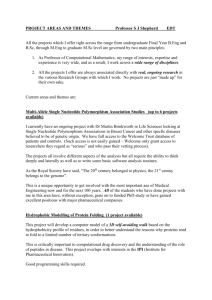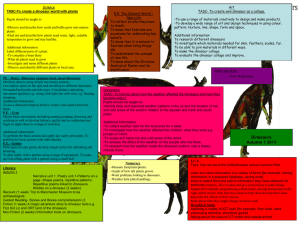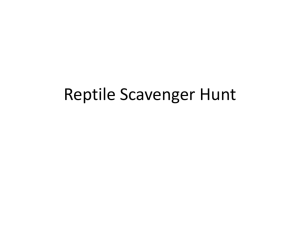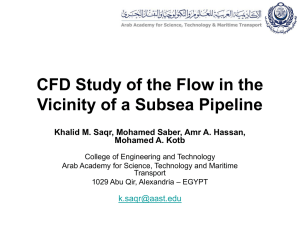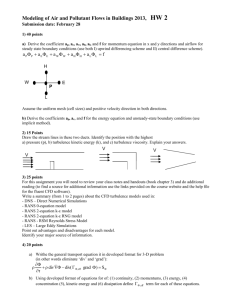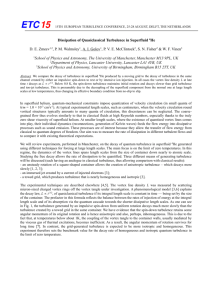Dinosaur Physiology
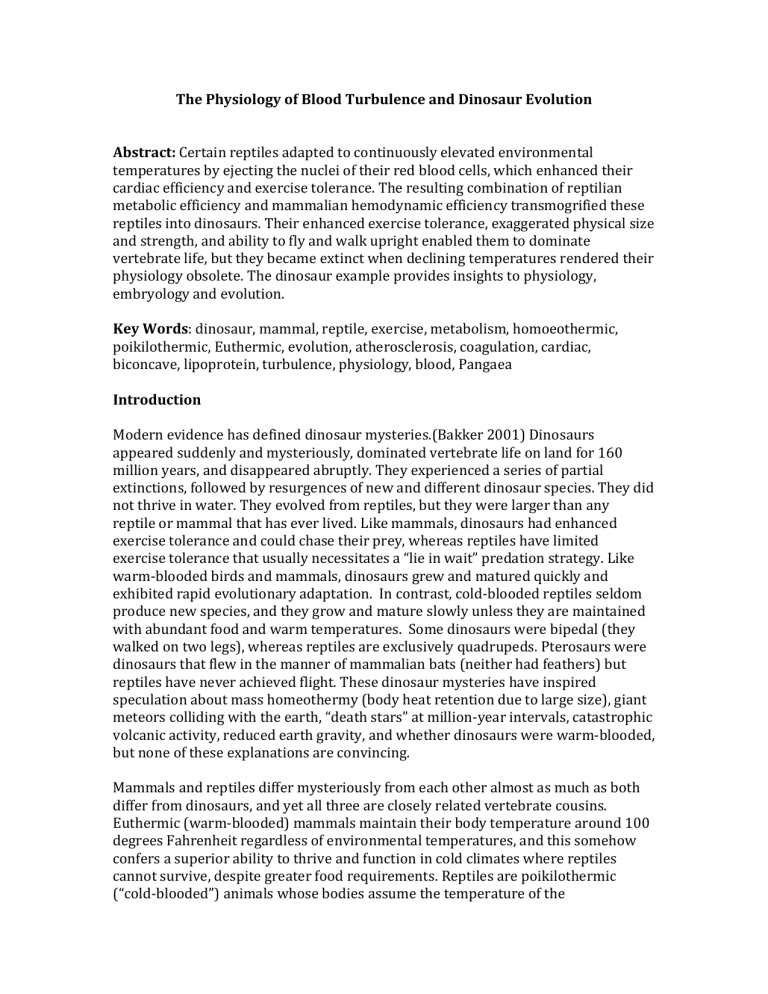
The Physiology of Blood Turbulence and Dinosaur Evolution
Abstract: Certain reptiles adapted to continuously elevated environmental temperatures by ejecting the nuclei of their red blood cells, which enhanced their cardiac efficiency and exercise tolerance. The resulting combination of reptilian metabolic efficiency and mammalian hemodynamic efficiency transmogrified these reptiles into dinosaurs. Their enhanced exercise tolerance, exaggerated physical size and strength, and ability to fly and walk upright enabled them to dominate vertebrate life, but they became extinct when declining temperatures rendered their physiology obsolete. The dinosaur example provides insights to physiology, embryology and evolution.
Key Words: dinosaur, mammal, reptile, exercise, metabolism, homoeothermic, poikilothermic, Euthermic, evolution, atherosclerosis, coagulation, cardiac, biconcave, lipoprotein, turbulence, physiology, blood, Pangaea
Introduction
Modern evidence has defined dinosaur mysteries.(Bakker 2001) Dinosaurs appeared suddenly and mysteriously, dominated vertebrate life on land for 160 million years, and disappeared abruptly. They experienced a series of partial extinctions, followed by resurgences of new and different dinosaur species. They did not thrive in water. They evolved from reptiles, but they were larger than any reptile or mammal that has ever lived. Like mammals, dinosaurs had enhanced exercise tolerance and could chase their prey, whereas reptiles have limited exercise tolerance that usually necessitates a “lie in wait” predation strategy. Like warm-blooded birds and mammals, dinosaurs grew and matured quickly and exhibited rapid evolutionary adaptation. In contrast, cold-blooded reptiles seldom produce new species, and they grow and mature slowly unless they are maintained with abundant food and warm temperatures. Some dinosaurs were bipedal (they walked on two legs), whereas reptiles are exclusively quadrupeds. Pterosaurs were dinosaurs that flew in the manner of mammalian bats (neither had feathers) but reptiles have never achieved flight. These dinosaur mysteries have inspired speculation about mass homeothermy (body heat retention due to large size), giant meteors colliding with the earth, “death stars” at million-year intervals, catastrophic volcanic activity, reduced earth gravity, and whether dinosaurs were warm-blooded, but none of these explanations are convincing.
Mammals and reptiles differ mysteriously from each other almost as much as both differ from dinosaurs, and yet all three are closely related vertebrate cousins.
Euthermic (warm-blooded) mammals maintain their body temperature around 100 degrees Fahrenheit regardless of environmental temperatures, and this somehow confers a superior ability to thrive and function in cold climates where reptiles cannot survive, despite greater food requirements. Reptiles are poikilothermic
(“cold-blooded”) animals whose bodies assume the temperature of the
environment. Their activity is temperature-dependent, and they become extremely sluggish when cold. They have poor exercise tolerance even when they are warm, and they become exhausted quickly, but they can survive for extended periods of time with very little food. Both the cold sensitivity of reptiles and advantage of mammalian euthermia remain unexplained.
The author once witnessed the extreme cold sensitivity of reptiles on a raft trip in the Grand Canyon when guides dumped cold river water on a rattlesnake that lurked near the latrine. The snake was immediately immobilized, and could then be safely picked up and flung into the bushes.
This paper will explain how simple modifications in metabolism and red blood cell morphology enable vertebrates to adapt to different climates. These modifications entail “trade-offs” between exercise tolerance, food requirements, and cold sensitivity. They involve lipoprotein temperature sensitivity, blood turbulence, and atherosclerosis, and they explain the fundamental differences between and among reptiles, mammals and dinosaurs.
Lipoprotein Temperature Sensitivity and Metabolism
Unlike proteins and carbohydrates, fat is insoluble in blood. The digestive process breaks fat into small molecules and combines these with proteins to form lipoproteins that can be suspended in blood and transported to cells. At mammalian body temperatures (around 100 degrees Fahrenheit), lipoproteins are liquefied, and their effects on blood flow are minimized.(Dintenfass 1965) Below mammalian body temperatures, lipoproteins convert from liquid to solid particulates that inhibit blood flow and accelerate atherosclerosis.
Temperature-dependent lipoprotein solidification can be observed in venous blood drawn from humans after a meal. As the blood samples cool, lipoproteins solidify and float to the top of the test tube, where they form a white layer. The author has observed that portal veins turn pearly white due to lipoprotein solidification when exposed intestines are cooled during surgery, but systemic vessels remain unaffected. The portal veins conduct blood from the intestines to the liver, so that blood flowing from the intestines must pass through the liver before entering the systemic circulation. This prevents harmful solidified lipoproteins as well as toxins from entering systemic circulation.
Red Blood Cell Morphology, Blood Turbulence, Atherosclerosis, and Exercise
Tolerance
Water, oil, and most other fluids are called “Newtonian” because they exhibit exponential increases in turbulence when they are accelerated in pipes. The turbulence causes exponential increases in flow resistance and generates lateral forces that press on the inner walls of the pipe. Belgian mechanical engineers recently photographed pipe flow turbulence and showed that it consists of small “jet
streams” that flow forward along the inner walls of the pipe and force slowermoving fluid elements to the center of the pipe, where they flow backward. This explains how turbulence inhibits forward flow in pipes, and also how it mobilizes particulates that would otherwise deposit on the walls of the pipe.(Chris Woodyard
2006; Hof et al. 2004)
(Insert Figure 1)
Figure 1: Newtonian Pipe Flow Turbulence (Hof et al. 2004) Turbulent forward flow appears as fast-moving
“jet streams” (shown in red) that form along the inner walls of pipes and force slow-moving fluid to the center, where it moves backward (shown in blue), causing increased viscosity (flow resistance). A, C and E are laser photographs that show “fast (A), faster (C) and fastest (E)” flow acceleration that produce “small
(A), medium (C) and large (E)” increases in turbulent intensity. B, D and F are computer simulations that predicted the experimental results shown by A, C and E. Similar arterial turbulence during diastole mobilizes particulate deposits from arterial walls to prevent atherosclerosis. It also generates lateral forces that press on the inner walls of the vessel, which explains blood pressure and the palpable pulse.
The pivotal role of vertebrate arterial blood turbulence remains unappreciated.
Blood turbulence affects flow resistance, cardiac efficiency, exercise tolerance, blood coagulability, and atherosclerosis, and it explains blood pressure, the palpable pulse, and bruits.
The secret of vertebrate hemodynamic physiology is efficiency rather than power and work. The modest force generated by cardiac muscle is consistent within a narrow range, and turbulent flow resistance readily inhibits the ability of the heart to expel its contents. Turbulent flow resistance and capillary flow resistance are simultaneously regulated in accord with autonomic balance by the capillary gate component of the Stress Repair Mechanism (SRM).(Coleman 2010) Turbulent flow resistance and/or capillary gate closure reduces cardiac output, cardiac efficiency, and exercise tolerance.
Vertebrate pulsatile arterial blood flow accelerates forward during systole, when the heart contracts. During diastole, when the heart relaxes, arterial flow decelerates and briefly halts. Pulsatile flow thus induces periodic bursts of arterial turbulence.
Vertebrate arterial turbulence is similar to water pipe turbulence, except that blood contains red blood cells that alter turbulence in accord with their shape and size.
Rotund, nucleated reptilian red cells exaggerate systolic blood turbulence to inhibit atherosclerosis. Biconcave, enucleated mammalian red cells inhibit systolic blood turbulence to enhance cardiac efficiency and exercise tolerance. This explains the presence of red blood cells in vertebrates, because hemoglobin encapsulation does not enhance oxygen delivery, and red cell mass is far greater than necessary to oxygenate tissues.
Pulsatile arterial turbulence inhibits coagulation, which explains why clot formation is rare in uninjured arteries, while thrombophlebitis is common in veins, where flow
is sluggish and turbulence is minimal. Insoluble fibrin generated by the Stress
Repair Mechanism (SRM) induces clot formation by reducing blood turbulence below a threshold, and then binding red blood cells into a viscoelastic clot.(Coleman
2005; Coleman 2010)
Blood turbulence inhibits atherosclerosis. Blood contains numerous particulates in addition to lipoproteins and red cells. Like sludge formation in oil pipes, blood particulates form deposits on the inner walls of arteries if blood turbulence is inadequate.(Chris Woodyard 2006) Such deposits induce an inflammatory reaction that results in the formation of atherosclerotic plaque. Athletic activity exaggerates blood turbulence that inhibits and can even reverse atherosclerosis. Anemia likewise increases blood turbulence and inhibits atherosclerosis. Polycythemia and sedentary life style reduce blood turbulence and accelerate atherosclerosis.
Atherosclerosis is a natural consequence of aging and inactivity, as cardiac vigor and blood turbulence decline. Insoluble Fibrin is generated in flowing blood by the SRM in accord with stressful forces and stressful stimuli that affect autonomic balance, and this reduces turbulent mixing in blood and thereby accelerates atherosclerosis.
This explains why atherosclerosis is accelerated by disease, surgery, and emotional stress. (Coleman 2006; Coleman 2010)
Reptile Physiology
Reptiles are “cold-blooded” (poikilothermic). They are adapted to warm climates.
They do not waste food energy to maintain their body temperature above the level of lipoprotein liquefaction. Their food requirements are therefore modest compared to mammals. Their body temperature fluctuates in accord with environmental temperatures, so that lipoproteins in their blood solidify at cool temperatures. Lipoprotein solidification inhibits blood flow and accelerates atherosclerosis. However, unlike mammalian red blood cells, reptilian red blood cells retain their nucleus, which causes their shape to remain rotund. This rotund shape exaggerates systolic blood turbulence, which offsets the acceleration of atherosclerosis caused by lipoprotein solidification. The exaggerated systolic blood turbulence simultaneously inhibits cardiac function by increasing flow resistance.
The combined effect of rotund red cells and solidified lipoproteins severely reduces cardiac efficiency and exercise tolerance at cool temperatures. This explains why reptiles become extremely sluggish at low temperatures. Reptiles typically bask in the morning sun to raise their body temperatures to mammalian levels, which is where they function best. However, even when their blood temperature is elevated above the level of lipoprotein liquefaction, their exercise tolerance remains inferior to that of mammals on account of the exaggerated turbulent systolic flow resistance caused by their rotund, nucleated red cells. Because of this, most reptiles employ a
“lie in wait” style of predation that requires minimal exercise capacity.
Mammal Physiology
Mammals are “Euthermic” (warm-blooded). They have adapted to cold climates by adjusting their metabolism to maintain their body temperature continuously above the threshold of lipoprotein liquefaction, and by ejecting the nucleus of their red blood cells to create biconcave red cells that enhance cardiac efficiency and exercise tolerance. Maintaining elevated body temperatures substantially increases food requirements, but it prevents lipoprotein solidification and enables mammals to remain active at cold temperatures, and the enhanced exercise capacity enables them to chase after their food in order to satisfy their increased food requirements.
Superior mammalian intelligence further enhances their ability to obtain food.
The nucleus of maturing mammalian red blood cells is ejected and engulfed by immune cells, causing the rotund cell to partially collapse to create its distinctive biconcave shape. During systole, when the heart contracts and ejects blood, these biconcave red cells spontaneously form “aggregate patterns” that inhibit blood turbulence and flow resistance so that the mammalian heart expels its contents much more efficiently. The mammalian heart is thus able to accelerate arterial blood flow from 0 to 125 cm/sec in a tenth of a second with minimal effort. This enhanced cardiac efficiency confers a substantial increase in exercise capacity.
During diastole, when the mammalian heart has emptied its contents and blood flow decelerates, the aggregate formations disintegrate, causing the kinetic energy of moving blood to convert to a burst of turbulence. This manifests as a traveling pulse wave that propagates throughout the arterial tree with each cardiac cycle, halting blood flow as it travels. The turbulence generates lateral forces that press on the inner walls of arteries. These lateral forces make the pulse wave palpable and blood pressure measureable. Arterial strictures and blood pressure cuff inflation accelerate blood flow and elevate turbulent frequencies to audible levels, which explains bruits and blood pressure measurement.
(Insert Figure 2)
Figure 2: Turbulence and Velocity in Pulsatile Blood Flow in a dog. Mammalian red blood cells spontaneously form aggregates that suppress turbulence during systole to enable rapid and efficient blood acceleration. Diastolic deceleration disrupts the aggregates and converts laminar systolic flow into diastolic turbulence that halts net forward flow. (Parker 1977) The brief flow reversal in the proximal aorta enhances turbulent cleansing relative to the distal aorta.(Bassiouny et al. 1994)
Blood turbulence clarifies vertebrate hemodynamic physiology. Red blood cells are nearly identical among mammalian species because their size and shape optimizes turbulence control. Heart mass is 0.6% of body mass in most mammals, which reflects mammalian hemodynamic efficiency. Mammalian blood pressure varies little between individuals and among species because cardiac power, force and work vary little from beat to beat, and because mammalian physiology controls temperature within a narrow range, so that turbulent forces remain consistent with each heartbeat and similar among species. However, blood pressure is not linearly related to cardiac output or tissue perfusion as often presumed. For example,
cardiac output remains intact in resting trained athletes and during normal sleep despite reduced blood pressure and pulse rate. The mammalian head is usually located near the heart, because the weak force that propels blood cannot readily perfuse distant or elevated brain tissues. Exceptions such as the giraffe require exaggerated heart mass. In contrast to mammals, reptilian blood turbulence, and therefore blood pressure, is affected by temperature, activity and other factors, so that it varies substantially in individuals as well as among species.
Human babies are born with immature spherical, nucleated red blood cells that are gradually replaced by mature biconcave, enucleated red blood cells during the first year of life. The fetal red cells exaggerate systolic blood turbulence to inhibit atherosclerosis during embryological development, when blood turbulence is otherwise inadequate in the quiescent developing fetus. The increased turbulent flow resistance caused by fetal red blood cells explains the limited exercise tolerance and increased risk of general anesthesia during the first year of human life.
Dinosaur Physiology
Dinosaurs were adapted to continuously hot temperatures. They thrived during the unique era when all the continents of the earth were fused together into a single land mass called “Pangaea”. This caused interior land temperatures to become continuously elevated above the level of lipoprotein liquefaction. Under these conditions, certain reptile species suddenly transmogrified into dinosaurs by ejecting the nucleus of their reptilian red blood cells to create biconcave red blood cells that enhance exercise capacity.(Liangtai 2009) In the presence of continuously hot temperatures, this single change in red cell structure added the superior hemodynamic efficiency (exercise tolerance) of mammals to the superior metabolic efficiency (modest food requirements) of reptiles to enable dinosaurs to become energetic monsters that dominated terrestrial life for millions of years.
The combination of metabolic and hemodynamic efficiency explains how planteating dinosaurs attained gigantic size despite small heads that limited their food intake. Their enhanced exercise tolerance facilitated their ability to obtain fresh plant food sources, but their additional food energy was not wasted to maintain body temperature, so that their conserved caloric intake exaggerated body size.
Enhanced dinosaur exercise capacity enabled dinosaur predators to run on two legs to chase after their prey and increase their caloric intake, while their metabolic efficiency exaggerated their size and strength, so that they become the most formidable predators ever known. The enhanced exercise capacity likewise enabled
Pterosaurs to fly in the manner of mammalian bats (both lacked feathers). The combination of hemodynamic and metabolic efficiency also enabled rapid growth, maturation and evolutionary diversification similar to warm-blooded mammals and birds.
Dinosaurs were not mammals, because they lacked the ability to maintain their body temperature above the level of lipoprotein liquefaction. Their adaptation to sustained high temperatures rendered them exquisitely vulnerable to cool temperatures. Because of this, they did not thrive in water, where temperatures are usually below the threshold of lipoprotein liquefaction. The fossil record reflects a series of catastrophic dinosaur extinctions followed by resurgences in which new and different dinosaur species appeared, and this is best explained by temporary declines in ambient land temperature below the level of fat liquefaction. When
Pangaea disintegrated into separate continents, causing land temperatures to permanently fall below the threshold of lipoprotein liquefaction, the dinosaur life form became extinct. The final chapter in the dinosaur saga likely resembled
Armageddon, as doomed dinosaurs clustered together in a desperate search for warmth. The contorted postures of their fossilized bodies may reflect their final agony as lipoprotein solidification disrupted their hemodynamic function.
Conclusion
The evolution of dinosaurs is often associated with cosmic climatic cataclysms, but the evidence indicates that the earth’s climate is remarkably temperate. It never becomes so extreme as to render either reptiles or mammals extinct. Instead, mild cyclical temperature fluctuations temporarily favor one versus the other. Dinosaurs represent a vertebrate adaptation to a unique period of increased land temperatures. The dinosaur evidence provides insights to vertebrate physiology, embryology and evolution. The ability to eject the nucleus of red blood cells is retained by reptiles as well as mammals, and it may represent one of many potential adaptations hidden in the vertebrate genome. It illustrates how simple physiological adaptations to moderate environmental changes can produce diverse new life forms that disappear as suddenly as they appeared. (Kirschner and Gerhart 2005)
This hypothesis of dinosaur origin and physiology resulted from the extensive review of published medical research literature that identified the “Stress Repair
Mechanism” (SRM) that maintains and repairs the vertebrate body and governs hemodynamic physiology.(Coleman 2010) Confirmation of the hypothesis initially appeared impossible, because the shape of dinosaur red blood cells was unknown.
However, Dr. Mary Schweitzer recently discovered intact dinosaur bone marrow tissue,(Fields 2006; Schweitzer et al. 2005; Schweitzer et al. 1997). Soon thereafter electron microscopy confirmed that dinosaurs had biconcave red blood cells.(Liangtai 2009) The ability of reptiles to transmogrify into dinosaurs could be confirmed by maintaining a selected group of reptiles with temperatures continuously above the threshold of lipoprotein liquefaction and abundant food.
Under these conditions, dinosaurs should appear spontaneously.
Bakker RT. 2001. The Dinosaur Heresies: New Theories Unlocking the Mystery of the Dinosaurs and Their Extinction: Citadel. 480 p.
Bassiouny HS, Zarins CK, Kadowaki MH, and Glagov S. 1994. Hemodynamic stress and experimental aortoiliac atherosclerosis. J Vasc Surg 19(3):426-434.
Chris Woodyard PDaBH. 2006. BP spill highlights aging oil field's increasing problems. USA Today: Gannett.
Coleman LS. 2005. Insoluble fibrin may reduce turbulence and bind blood components into clots. Med Hypotheses 65(4):820-821.
Coleman LS. 2006. Atherosclerosis may be caused by inadequate levels of turbulence and mixing. World J Surg 30(4):638-639.
Coleman LS. 2010. A Stress Repair Mechanism that Maintains Vertebrate Structure during Stress. Cardiovasc Hematol Disord Drug Targets.
Dintenfass L. 1965. Some Observations on the Viscosity of Pathological Human
Blood Plasma. Thromb Diath Haemorrh 13:492-499.
Fields H. 2006. Dinosaur Shocker. Smithsoniancom.
Hof B, van Doorne CW, Westerweel J, Nieuwstadt FT, Faisst H, Eckhardt B, Wedin H,
Kerswell RR, and Waleffe F. 2004. Experimental observation of nonlinear traveling waves in turbulent pipe flow. Science 305(5690):1594-1598.
Kirschner MW, and Gerhart JC. 2005. The Plausibility of Life: Resolving Darwin's
Dilemma: Vail-Ballou Press.
Liangtai L. 2009. Dinosaurs had mammalian red blood cells.
Parker KH. 1977. Instability in Arterial Blood Flow. Norman NHCHNA, editor.
Baltimore, Md: University Park Press, Chamber of Commerce Building,
Baltimore, Md. 21202.
Schweitzer MH, Chiappe L, Garrido AC, Lowenstein JM, and Pincus SH. 2005.
Molecular preservation in Late Cretaceous sauropod dinosaur eggshells. Proc
Biol Sci 272(1565):775-784.
Schweitzer MH, Marshall M, Carron K, Bohle DS, Busse SC, Arnold EV, Barnard D,
Horner JR, and Starkey JR. 1997. Heme compounds in dinosaur trabecular bone. Proc Natl Acad Sci U S A 94(12):6291-6296.


